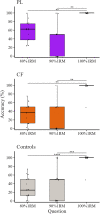Sensorimotor expertise influences perceptual weight judgments during observation of a sport-specific gesture
- PMID: 37426895
- PMCID: PMC10323826
- DOI: 10.3389/fspor.2023.1148812
Sensorimotor expertise influences perceptual weight judgments during observation of a sport-specific gesture
Abstract
This study aimed to investigate the role of sensorimotor expertise in evaluating relative weight of a lifted object during the observation of a sport-specific gesture, namely the deadlift. Fifty-six participants, assigned to three groups according to their experience in weight lifting, powerlifters, CrossFit® practitioners and naïve participants (controls), performed a perceptual weight judgments task. Participants observed videos showing a powerlifter executing a deadlift at the 80%, 90% and 100% of 1 repetition maximum (1RM) and answered a question about the weight of the lifted object. Participants' response accuracy and variability were evaluated. Findings showed that powerlifters were more accurate than controls. No differences appeared between powerlifter and CrossFit® practitioners, and between CrossFit® practitioners and controls. Response variability was similar in the three groups. These findings suggest that a fine sensorimotor expertise specific for the observed gesture is crucial to detect the weight of the object displayed in the observed movement, since it might allow detecting small changes in the observed movement kinematics, which we speculate are at the basis of the object weight recognition.
Keywords: action observation; motor expertise; motor resonance; sport expertise; weight estimation.
© 2023 Albergoni, Biggio, Faelli, Pesce, Ruggeri, Avanzino, Bove and Bisio.
Conflict of interest statement
The authors declare that the research was conducted in the absence of any commercial or financial relationships that could be construed as a potential conflict of interest.
Figures



References
-
- Johansson G. Visual perception of biological motion and a model for its analysis. Percept Psychophys. (1973) 14:201–11. 10.3758/BF03212378 - DOI
-
- Grossberg S. Visual motion perception. Encycl Hum Behav Second Ed. (2012) 232:637–51. 10.1016/B978-0-12-375000-6.00370-0 - DOI
-
- Beardsworth T, Buckner T. The ability to recognize oneself from a video recording of one’s movements without seeing one’s body. Bull Psychon Soc. (1981) 18:19–22. 10.3758/BF03333558 - DOI
LinkOut - more resources
Full Text Sources

